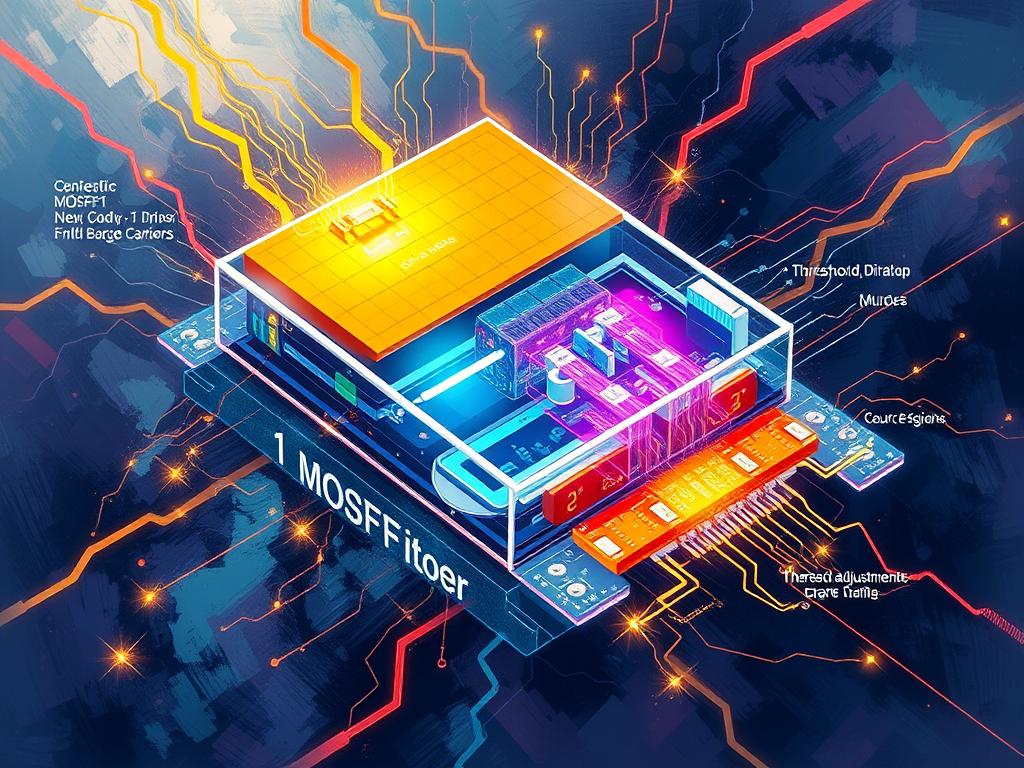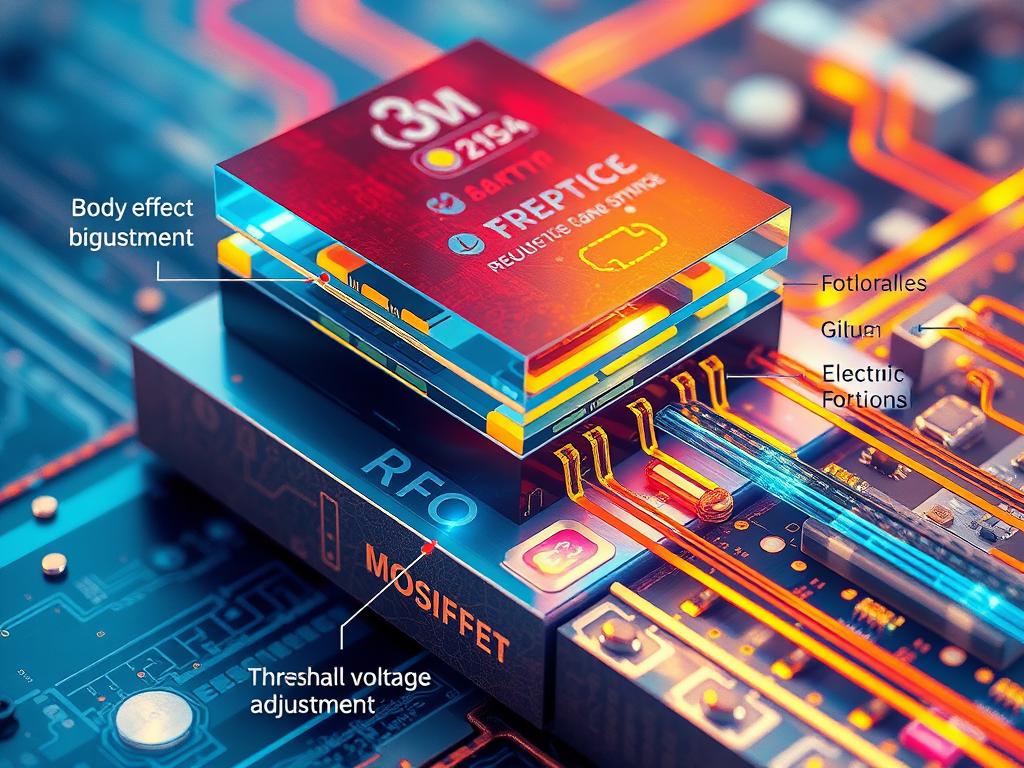Precise threshold voltage adjustment can boost circuit efficiency by up to 30%. Body Effect Control is the key to this improvement. Mastering this technique is crucial in modern microelectronics.
Body Effect Control fine-tunes MOSFET behavior in electronic designs. It optimizes power use and enhances signal quality across various devices. This technique shapes the performance of our everyday electronics.
Grasping Body Effect Control is vital for excelling in electronic design. It’s about crafting responsive and efficient circuits for today’s tech-driven world.
Dynamic Voltage Scaling works with Body Effect Control for real-time power adjustments. This approach ensures peak device efficiency, regardless of workload. These techniques push the limits of electronic performance.
Introduction to Body Effect Control
Body Effect Control is vital in modern electronic design. It allows engineers to fine-tune transistor behavior, enabling Substrate Bias Tuning for optimal performance. This technique is significant across various industries.
What is Body Effect Control?
Body Effect Control adjusts a transistor’s threshold voltage by changing the substrate bias. In MOSFETs, this alters the voltage needed to create a conducting path.
For n-channel enhancement-mode FETs, the typical threshold voltage is about 0.45 V. This control mechanism is key to achieving desired transistor performance.

Importance in Electronic Design
This control mechanism is crucial for Low-Power Design and Process Variation Compensation. Engineers can optimize circuit performance and reduce power consumption through fine-tuning.
It also helps compensate for manufacturing variations. The body effect is especially important in nanoscale technologies.
- Optimize circuit performance
- Reduce power consumption
- Compensate for manufacturing variations
In 90-nm technology, a gate-oxide thickness of 1 nm helps control subthreshold leakage current. This feature is essential for efficient transistor operation.
Applications Across Industries
Body Effect Control is used in various sectors:
| Industry | Application |
|---|---|
| Telecommunications | Signal amplification in mobile devices |
| Consumer Electronics | Power management in laptops and smartphones |
| Automotive | Engine control units and safety systems |
Power MOSFETs in D2PAK packages can block 120V off and conduct 30A continuously. This makes them ideal for automotive applications.
Precise threshold voltage control is crucial for implementing pulse-width modulation in these systems. It ensures efficient and reliable operation in various electronic devices.
Mechanisms Behind Body Effect Control
Body effect control is vital in modern transistor designs. It impacts the performance and efficiency of electronic devices. Let’s explore how it works and its real-world uses.
How Body Effect Works in MOSFETs
In MOSFETs, the body effect changes the threshold voltage. This alteration affects transistor behavior and is key to Leakage Power Management.
Designers can fine-tune transistor performance by adjusting the substrate voltage. This technique allows for optimal results in various applications.

Influence of Substrate Biasing
Substrate biasing is a powerful tool for Performance Optimization. It helps control leakage current and adjust switching speeds.
This technique is crucial for Energy Efficiency Enhancement in modern circuits. Engineers can balance power consumption and speed by manipulating substrate voltage.
Real-World Examples of Body Effect in Action
Body effect control is used in mobile processors for dynamic voltage scaling. This application helps extend battery life in portable devices.
IoT devices benefit from low-power analog circuits designed with body effect in mind. These examples show how body effect control creates energy-efficient, high-performance electronics.
| Application | Benefit | Impact |
|---|---|---|
| Mobile Processors | Dynamic Voltage Scaling | Extended Battery Life |
| IoT Devices | Low-Power Analog Circuits | Reduced Energy Consumption |
| Wearable Tech | Efficient Signal Processing | Improved Performance |
Engineers working on amplifier circuits must understand these mechanisms. Mastering body effect control enables the creation of efficient, powerful devices across industries.
Applications of Body Effect Control in Modern Technology
Body Effect Control shapes modern electronic designs. It enhances circuit performance, optimizes power amplifiers, and refines analog and digital circuits. Its impact spans various applications in today’s technology.
Enhancing Circuit Performance
The body effect in MOSFETs influences circuit performance, especially in low-voltage applications. Designers can fine-tune transistor characteristics for optimal operation by controlling this effect. This control is crucial for Performance Optimization in electronic systems.
Impact on Power Amplifiers
Body Effect Control improves efficiency and linearity in power amplifiers. MOSFETs can handle substantial power in various ways.
- Sustaining a blocking voltage of 120 V in the off state
- Conducting a continuous current of 30 A in the on state
- Dissipating up to about 100 W
- Controlling a load of over 2000 W
Role in Analog and Digital Circuits
Body Effect Control is crucial in both analog and digital circuits. In analog designs, it allows precise control of transistor characteristics.
This improves signal integrity and reduces noise. For digital circuits, it enables Power Gating and Dynamic Voltage Scaling.
These techniques reduce power consumption in modern processors and mobile devices.
| Circuit Type | Body Effect Impact | Benefits |
|---|---|---|
| Analog | Alters transconductance and drain current | Improved linearity and gain |
| Digital | Affects switching characteristics and timing | Enhanced power efficiency |
MOSFETs, with effective Body Effect Control, are indispensable in modern electronics. They’re used in microprocessors with billions of transistors.
High-performance amplifiers also benefit from this technology. The impact of Body Effect Control is profound and far-reaching.
Strategies for Optimizing Body Effect Control
Circuit designers struggle to balance performance and power use. Body effect control is vital for this balance. It involves adjusting voltage and tuning substrate bias for better energy efficiency.
Best Practices for Circuit Designers
Good body effect control requires understanding trade-offs. Designers should focus on key areas.
- Analyzing circuit requirements
- Selecting appropriate transistor types
- Fine-tuning threshold voltages
- Implementing substrate bias techniques
These practices help boost performance and cut power use. It’s important to consider how transistors affect energy efficiency in circuit design.
Leveraging Simulation Tools
Advanced tools are crucial for optimizing body effect control. They help designers in many ways.
- Model body effect behavior under various conditions
- Predict circuit performance accurately
- Experiment with different threshold voltage adjustments
- Optimize substrate bias tuning
These tools offer insights that guide energy efficiency strategies.
Case Studies: Successful Implementations
Real-world examples show how effective body effect control can be:
| Application | Strategy | Result |
|---|---|---|
| Mobile Processors | Dynamic threshold voltage adjustment | 30% power reduction |
| IoT Devices | Adaptive substrate bias tuning | Extended battery life by 40% |
| 5G Base Stations | Combined threshold and bias optimization | 25% improvement in energy efficiency |
These studies show how body effect control improves energy efficiency. Designers keep refining these methods as tech advances. They push the limits of energy efficiency enhancement in electronic circuits.
Body composition control strategies are also important. Focusing on improving body composition leads to better health. This mirrors the precision in electronic circuit optimization.
Future Trends and Innovations
Body effect control is changing fast due to new tech and industry shifts. Future innovations will shape the next generation of electronic devices and systems.
Emerging Technologies Influencing Body Effect
Advanced FinFET structures and Silicon-on-Insulator processes are leading body effect control innovations. These techs improve transistor design, allowing better control of device features.
Using dynamic voltage scaling is key for managing power use in complex circuits. This helps create more efficient electronic devices.
Predicted Industry Shifts
The industry is moving towards ultra-low-power design for IoT and edge computing. This shift requires better body effect control to save power.
Process variation compensation is becoming more important. It helps maintain consistent chip performance. The auto sector prefers centralized Body Control Module setups and improved cybersecurity.
Importance of Continued Research and Development
Ongoing research in body effect control is vital for nanoscale transistor design. It also helps improve energy efficiency in electronic devices.
The field is expanding into quantum computing and neuromorphic systems. These areas need precise control over device features.
As innovative technologies grow, body effect control becomes more crucial. This drives the need for more advances in electronic engineering.


